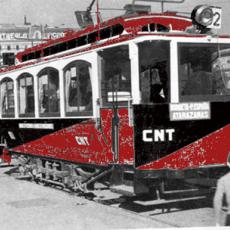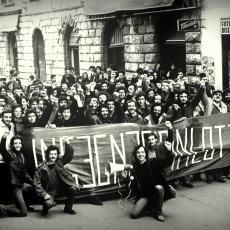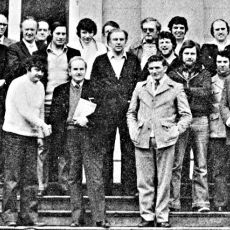On cyber syndicalism: From Hacktivism to Workers’ Control
Cyber activists need to devote more attention to direct action in tech workplaces and organized efforts toward workers’ control.
Alternative globalization movements in the global North, from their high point in the Quebec City mobilizations against the Free Trade Area of the Americas in 2001 to the present, have been faced with the challenge of rebuilding and finding new ground on which to re-mobilize since the political reaction set in following the 9/11 attacks which derailed momentum and caused many mainstream elements (especially labor unions) to disengage and demobilize (where not playing to the forces of “law and order” reaction). One effect of the post-9/11 freeze (it has been more than a chill) has been the drift away from grounded community (it was never much involved in workplace organizing), outside of some important cases such as indigenous land struggles, as in Ontario and British Columbia, and some direct action anti-poverty movements (like the Ontario Coalition Against Poverty). Instead much organizing has followed certain lines of flight — crucial in the formation of alternative globalization movements from the Seattle protests against the World Trade Organization in 1999 — to online activism (in indymedia, hacking, social media, and so on).
In some ways radicalism has continued and developed more consistently, or even fully, online than it has offline in community organizing. Partly, this is an effect of the surveillance apparatus and protest policing that has aggressively targeted “on the ground” movements.
The cyber sphere has provided some spaces for maneuver not available in the streets or in the hood. On the one hand, movement commentators have noted the decline of movements in the period after 9/11 up to the moment of brief resurgence manifested in the Occupy encampments. On the other hand, the cyber disobedients have offered some inspiration and reason for hope. Indeed, the networks of the web have been perhaps uniquely important in allowing for some ongoing activity connecting social movement organizers during the period of decline and dissipation of struggles. Indeed, this is always an important task — maintaining movements through inevitable low periods of struggle and sustaining some capacity for collective re-emergence and revival as possibilities for an uptick of struggles open up. This was perhaps more difficult in periods prior to the development of the web when opportunities for communication, skill sharing, and resource circulation were more limited or localized and when demoralization within face-to-face circles could finish a movement.
The future potential of movements in struggle will rely in part on the growing convergence, even symbiosis, of the cyber disobedients and the direct actionists of the streets. Even more important will be the grounding of this action and organizing in specific workplaces and neighborhoods in ways that challenge fundamentally relations and structures of ownership, control, and exploitation.
Counterpower
Cyber anarchy represents a real form of counterpower as discussed by autonomist Marxist Antonio Negri. For Negri, a counterpower involves three distinguishable aspects. These are resistance (against the old power); insurrection; and what he calls potenza, or that which is constitutive of a new power (or constituent power).
Popular accounts of social struggle tend to focus on the insurrectionary aspects of cyber disobedience, or sometimes (rarely) give a sense that there is resistance being undertaken, but never on the potenza of this practice. Never, either, is it hinted at that there is, in fact, a counterpower in play. That is perhaps not too surprising given the hegemonic function of media and state discussions of online activism.
Where insurrection pushes resistance to innovation, potenza or constituent power expresses new projects of life. For Negri: “And, whereas the insurrection is a weapon that destroys the life-forms of the enemy, constituent power is the force that positively organizes new schemas of life and mass enjoyment of life” (2008, 140). This is not a replacement of existing power (in the sense of the Leninist workers’ state). It is not to take over the reins of the old power. Rather it is to develop new, alternative forms of organization and production — of the commons, of life.
Resistance to the dominant power must be built from the bottom if it is to contribute to the expression of a counterpower. As Negri suggests: “Resisting it from the bottom means extending and building into the resistance the ‘common’ networks of knowledge and action, against the privatization of command and wealth. It means breaking the hard of exploitation and exclusion. It means constructing common languages, in which the alternative of a free life and the struggle against death can emerge victorious.” (2008, 147)
The building of resistance from the ground up and the manifestation of potenza requires the development, maintenance, and extension of shared resources and organization. That is, it requires the construction of what Shantz (2010) has termed infrastructures of resistance. Infrastructures of resistance are those resources that sustain communities in struggle (through food, child care, education, shelter, and so on) while also allowing for the intensification of struggles. In previous periods, important infrastructures of resistance have included union halls, working class newspapers, mutual aid societies, anarchist free schools, and so on. In the present period many of the infrastructures of resistance in poor and working class communities have been destroyed or dissipated after decades of neoliberal assault and the professionalization and legalization of union structures and practices.
The decline of infrastructures of resistance has been accompanied by, and in part caused by, the drift of resistance into “activism,” detached from communities of the working class and oppressed. Activism stands as the separation of social and political action into a distinct realm — most typically symbolic street protests — taken up and managed by “activists.” The activists tend to be more privileged, at least economically and culturally, having had professional training in post-secondary institutions, and are not necessarily intrinsically connected with the communities they seek to represent or “defend.” At the same time they tend to fall back on specific, familiar, activist repertoires to express their dissent (marches, demonstrations, banner drops, and so on). Media savvy their politics are typically symbolic and geared at “awareness raising” or the venting of anger — each geared towards achieving coverage in the media. Protest actions tend to be of a consumerist nature (including against social service agencies) rather than on the basis of directly experienced exploitation in the workplace or labor market.
While this has limited, and in a sense detached and weakened, social struggles, the limitations of such political action (mirrored by the drift of unions into contract management and lobbying) show the need to (re)build infrastructures from the ground up. This includes the tech infrastructures wielded by the cyber disobedients.
Return to the roots: On Cyber Syndicalism and Workers’ Control
In thinking about the context for survival of connectivity and extension of cyber disobedience it is perhaps worthwhile going back to the future, once again. Perhaps too much of cyber activism, and activism in general, has moved online (in hacking, info releases, DOS attacks and so on). One outcome has been a certain loss of connectivity — of the type that connects cyber disobedience with real world material networks in specific contexts of grounded struggle — in workplaces and communities of the working classes and oppressed. Perhaps what is much, if not most, needed is a return to the material context of cyber production (and distribution).
In this there is much to be re/learned by a return to the organizing practices and perspectives of the cyber Wobblies of TAO Communications. Due to the fetishization of the “new,” which has become a driving mania of the global cyber age, TAO members sought to embrace something with a bit more history and substance, even if viewed as rather old or passé, the anti-authoritarian revolutionary politics of anarcho-syndicalism, or revolutionary unionism. TAO (a playful acronym for variously The Anarchy Organization or The Apples and Oranges and others) wanted to push against the closing window of the open (non-enclosed) web by opening up sourcecode and access, securing any and all worker-owned and operated access, and cultivating an internationalist network based on mutual aid and sharing rather than profit.
TAO workers sought to maintain and defend autonomy and be able thereby to extend support, infrastructure, and relative security to radical communications. As workers, secretaries and coders for student, labor, and environmental groups, the emphasis was placed on social struggle, on bodies in the workplaces, communities, and streets, rather than so-called “virtual” reality. TAO traveling organizers denied the Internet’s very existence (as a mythologized space free from labor and class), and spoke instead about ownership of the means of production and other such sticky aspects of old-fashioned materiality.
Several projects were initiated or taken forward to secure gains in struggle. Among the most important or durable of the online efforts has perhaps been A-Infos. A-Infos was a mailing list gleaned from various paper addresses the Toronto publication Anarchives had gathered since the 1960s, joined with the e-list established by the I-AFD in Europe, and supported by Freedom Press, which has operated out of London since Kropotkin and others started it in the 1880s. A-Infos came to be carried on its own server within the TAO matrix, and its multiple lists and digests distribute news “by, for, and about” anarchists to over 1200 subscribers in at least 12 languages, with substantial daily traffic, as well as print and radio reproduction around the world. A-infos became the most important daily news source on anarchist activities. It has been crucial in posting anarchist calls for participation in various struggles continuing to today.
Other projects supported by TAO with more or less success include: The Student Activist Network, the Direct Action Media Network (an unfortunately defunct precursor to the Indymedia conglomerate), PIRG.CA (public interest research groups in the Canadian context). Recent solidarity projects include work with the Ontario Coalition Against Poverty, Esgenoopetitj (colonial name: Burnt Church) First Nations, CUPE 3903 (strike-winning teaching assistants at York University), and numerous groups formed to oppose imperialist wars after September 11. From the original single machine, TAO came to operates at least eight boxes, serving the needs of more than 1000 members, a spread of organizations and individuals, who self-manage thousands of lists, hundreds of web pages, as well as databases. Besides basic shell access without advertisements or space quotas, organized TAO workers have provided secure access to web-based e-mail, secure online communications, and more.
In 1999 TAO workers joined the Industrial Workers of the World (IWW) with the intention of forming a branch amongst telecom workers in the Toronto area. It was believed that this would solidify syndicalist and co-operative structures, help with the rotation of job tasks, improve benefits for TAO workers, and generally raise class consciousness, particularly in the on-line arena where labor is too often made invisible and victimized by speed need.
TAO members, crucially, saw themselves first and foremost as tech workers involved in a specific, if shifting, mode of production, wielding specific means of production, and connected through particular relations of production. Their impetus was a primal (rather than neo) one. It was the impetus of the worker struggling to overcome exploitation, gain or maintain control of one’s production, and determine the nature of their work (and livelihood), and the conditions of their communities.
The most significant possibilities of cyber disobedience do not rest with direct action hits on state or corporate targets. There is a potential for real power in the collective actions of hacktivists as tech workers directly, and collectively, at the point of production, as TAO workers suggested almost at the beginning of the popular web. During times of a strike of tech workers everyone can see whose labor makes the wi-fi and internet possible. When that labor is withdrawn the system literally goes offline. With growing areas of states and capital entirely dependent on cyber infrastructures, any collective action by tech workers can have a dramatic impact, threatening the basis of command and profit and starkly posing questions of ownership and control.
Even more than collective strike actions, hacktivists can contribute to the remaking of tech resources for purposes that serve a tech (and social) commons as Squire suggests:
The potential, though, does not end with bringing IT systems down. Their role as the experts in the configuration and use of IT infrastructure also means that IT workers, organised as part of the working class, have the potential to reshape some of the existing IT infrastructure so that it can be used by, for and in the interests of the working class as a whole – removing copyright restrictions on online data or remodelling for-profit websites so that they are freely accessible to everyone, for example. IT workers can play a role in reclaiming the online commons. (2013, n.p.)
As TAO members argued more than a decade ago, hacktivists must come to see themselves as tech workers who have specific skills that can be used, not only reactively or as activists, but constructively and productively. This is a constructive anarchy involved in the building of infrastructures of resistance (Shantz 2010). The possibilities for organizing on a class basis as tech workers over issues of exploitation and control of labor may expand as tech work becomes more and more deskilled and/or devalued. This is an ongoing process of what some commentators refer to as the “proletarianization” of tech work (Squire 2013).
The possibilities for a better alternative emerging — in place of the authoritarian forms of what might coalesce as neo-fascism or prison-industrial capitalism — are dependent upon rooted material forms of organization and the preparatory building of the infrastructures of resistance. Tools and practices of cyber disobedience will be important parts in the day- to-day work of these infrastructures of resistance and in their construction, but they are not a substitute for the organizations, resources, and relationships that make up infrastructures of resistance themselves. This is what the early TAO organizers understood clearly, but which many later generations of cyber activists have lost track of.
Cyber anarchists, and activists more broadly, need to devote more attention to affirming what they want — what they are for rather than what they are against — and preparing conditions, providing means, by which it might be realized. Direct action in tech workplaces, and organized efforts toward workers’ control can secure these means — indeed, they will not be secured without syndicalist organizing in tech industries.
References
Negri, Antonio. 2008. Reflections on Empire. London: Polity
Shantz, Jeff. 2010. Constructive Anarchy: Building Infrastructures of Resistance. Surrey: Ashgate
Squire, Jo. 2013. “Anonymous and the Future of Hacktivism.” Socialist Alternative 27. http://sa.org.au/index.php?option=com_k2&view=item&id=7760:anonymous-and...
Summer, Kay and Harry Halpin. 2010. “The Crazy before the New.” In What Would it Mean to Win?, eds. Turbulence Collective. Oakland: PM Press, 113–120.






Comments
Post new comment